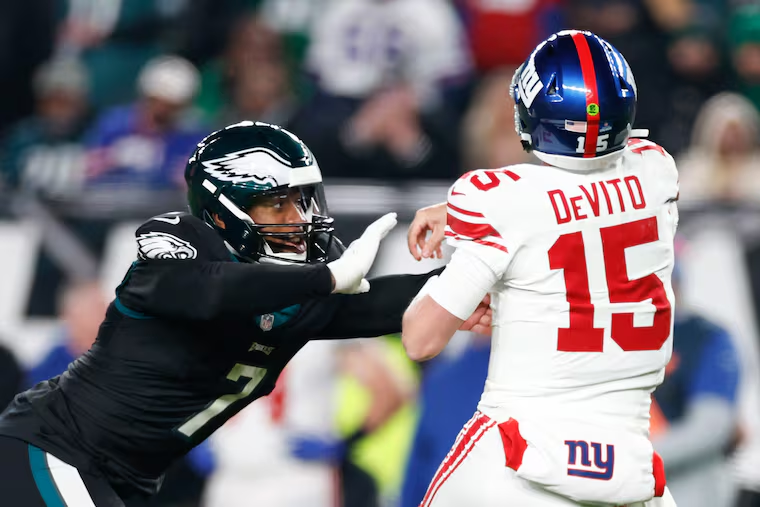Should the Eagles trade Haason Reddick? Sure, if possible.
The Eagles desperately need the skill that Reddick offers, but he isn’t the kind of guy who is worth mortgaging future payroll flexibility.

If Haason Reddick wants to be paid like one of the top edge rushers in the game, then he wants to be paid too much. If another team is willing to compensate him thusly, and to compensate his current employer for the right to do so, then Howie Roseman and Nick Sirianni should do everything in their power to facilitate the transaction.
That’s about as simple as it gets in the case of Reddick v. Eagles.
I don’t know if I’ll go as far as calling this a canary in the coal mine, but the ongoing drama between the Eagles and their resident Sack King could serve as a nice little preview of the years ahead for Roseman and his byzantine salary cap sheet. The piper needs to be paid.
For the last couple of seasons, Reddick has been held up as the prime example of Roseman’s ability to run circles around other NFL general managers. His 30½ sacks in 38 games (regular season and playoffs) have come at the expense of cap hits of $3.88 million in 2022 and $6.96 million in 2023. That’s less than $11 million in total payroll space, or less than what the 49ers were dinged for Nick Bosa in 2023 alone.
Genius? Well, it depends. Thing is, the Eagles have already paid Reddick a lot more than $11 million in actual cash. Nearly three times as much, in fact. According to Spotrac, Reddick collected about $31.5 million in 2022 and 2023. The NFL accountants don’t simply forget about that money. Every dollar spent eventually counts against the cap, however far into the future.
For Reddick, 2024 is that year. If he remains with the Eagles for the final year on his contract without agreeing to a new deal, he will count $21.9 million against the cap. Even if they cut him or trade him, they’ll still have to count all of the money they already paid him. Right now, it’s a break-even proposition.
In other words, Reddick has plenty of leverage. Which is why it is so difficult to predict the outcome of the ongoing staring contest. Just look at the last 48 hours. First came the report that the Eagles had granted Reddick permission to seek a trade. Then came a rebuttal from Reddick, saying he had not requested a trade and wanted to sign an extension with the Eagles. This is the normal course of things when a player’s valuation of himself does not align with that of his team.
The ideal outcome for the Eagles is to persuade Reddick to agree to a new multiyear deal that enables them to continue paying off the money they’ve already paid him while still benefiting from his services over the next two or three seasons, with the annual cap hit checking in at less than the current $21.9 million. But Reddick will already be getting $14.5 million in new cash by way of his 2024 salary. So, there isn’t a huge amount of wiggle room.
» READ MORE: What if the Eagles had drafted Kyle Hamilton when they had a chance?
A trade would benefit everybody, except, perhaps, for the team that is actually trading for Reddick. Even if there is a win-now team with plenty of cap space that is comfortable giving Reddick a top-of-the-market extension, is that team really going to be willing to part with a second-round pick to do it? If not, does it really make sense for the Eagles to eat a cap hit that could be as big as what it would cost to have Reddick play out the final year of his deal?
I know this: The Eagles are at a point that requires extreme fiscal discipline. The time is fast approaching when they will need to pay DeVonta Smith, and Landon Dickerson, all while Jalen Hurts’ cap figures continue to balloon.
Reddick is a good player with an elite skill. But he is heading into his 30-year-old season and coming off a year in which that one elite skill didn’t pay nearly as big of a dividend as it did in 2022. Holding the edge is just as important as collapsing it. Teams routinely took advantage of Reddick’s deficiencies against the run. Guys who can get to the quarterback are rare, which is why Reddick’s pluses outweigh his minuses. But he went sackless in 10 of 18 games in 2023. His sack total plunged from 19½ in the regular season and playoffs in 2022 to 11 in 2023.
The discourse surrounding Reddick’s role was a runaway train down the stretch. A short list of edge rushers who played in coverage more frequently than he did, according to Pro Football Focus: T.J. Watt, Alex Highsmith, Khalil Mack, Josh Allen. Elite edge players contribute in all sorts of ways. Myles Garrett was credited with 22 run stops on 301 snaps. Bradley Chubb, who played for Vic Fangio in Miami, had 22 on 305. Watt (24 on 323), Highsmith (24 on 357), Nick Bosa (29 on 378) — all of them contribute even when they aren’t getting to the passer. Reddick? He was credited with nine stops on 275 run snaps.
Don’t get me wrong. The Eagles desperately need the skill that Reddick offers. There aren’t many scenarios where they are a better team in 2024 without him. But he isn’t the kind of guy who is worth mortgaging future payroll flexibility for. That is a luxury they can no longer afford.